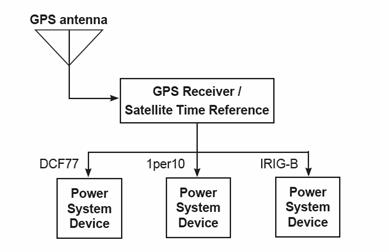 |
| Generic GPS synchronization architecture for power system |
Precision timing is required for monitoring and control of electrical power networks where power system reliability is important. Circuit breaker control schemes require precise timing to ensure proper operation, and Sequence of Events Recording systems report events with one-millisecond precision to aid diagnostics and troubleshooting. Typical “critical power” applications include electric utility networks, data centres, hospitals, water treatment plants, refineries, and other process industries.
Global Positioning Systems can be used to provide a precise time reference for power system devices in an electrical network, ensuring time synchronization even across great distances. A generic GPS system architecture is shown below:
A GPS antenna receives a time signal from the system of satellites orbiting the Earth. A GPS receiver accepts raw time data from the antenna and converts it to one or more time protocols.
Each power system device accepts a sync pulse, usually via a dedicated, high-speed digital input. The device then sets its internal clock by decoding the supported time protocol. Several time protocols are available, each with its advantages:
Each power system device accepts a sync pulse, usually via a dedicated, high-speed digital input. The device then sets its internal clock by decoding the supported time protocol. Several time protocols are available, each with its advantages:
- IRIG-B — time codes originally developed by the US military and widely used by electric utilities and others, especially in the United States. IRIG-B is typically distributed as a DC level shift (unmodulated IRIG-B) with 100 pulses per second. Examples of devices which implement IRIG-B include PowerLogic ION-8600 meters from Schneider Electric and SER-3200 event recorders from Cyber Sciences.
- DCF77 — standard time protocol well-suited to power applications because it requires less processor overhead than IRIG-B, yet offers equivalent accuracy. The 24Vdc pulse provides a complete date/time string once every minute. The DCF77 signal is broadcast from Germany and can be accessed from most of Europe via a dedicated DCF77 receiver. Alternatively, a GPS receiver can be used to accept a GPS signal, convert this to DCF77, and distribute the signal to multiple devices. Examples of devices which support DCF77 include PowerLogic series CM3000 and CM4000 meters, PM870 meters, and Quantum PLCs using an ERT module, by Schneider Electric. (More on DCF77)
- 1per10 — time synchronization protocol used by Sepam relays by Schneider Electric. One pulse every 10 seconds provides a precise time reference enabling Sepam relay clocks to maintain accurate time and date. In fact, an approximate date and time is provided to Sepam by some other means (e.g., supervisory software), and the GPS time-sync pulse is used to achieve higher accuracy. (More on 1per10)
Network Time Protocol is a web protocol used to provide a time reference over an Ethernet network or even the Internet. However, the accuracy that can be achieved with this approach is normally on the order of one second – not sufficient for the one-millisecond precision required in most critical power applications.
A relatively new standard for precision time synchronization is defined by the IEEE in standard IEEE-1588 (also known as “Precision Time Protocol” or PTP). Using the IEEE-1588 protocol, devices can achieve sub-millisecond accuracy over an Ethernet network. However, special Ethernet hardware is required, and the protocol is not yet widely available in electrical power devices. In the future, it is likely to be implemented widely in power system, in conjunction with GPS technology.
GPS time synchronization is especially useful when power system devices are located in different physical locations, such as several buildings in a campus arrangement or multiple substations separated by great distances.